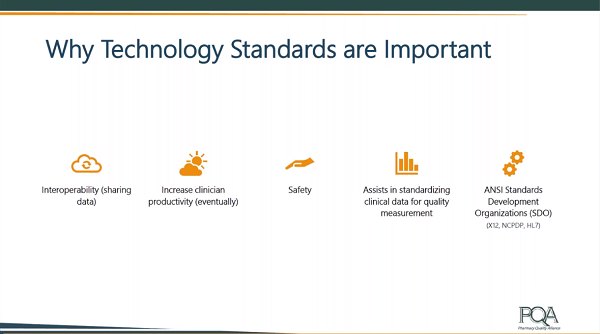Shelly Spiro, Executive Director at Pharmacy HIT Collaborative, spoke at PQA’s Data and Interoperability Advisory Group (DIAG) meeting on June 22. She discussed the importance of data standards for collecting and sharing information about pharmacist-provided patient care and services.
This blog provides an overview of Spirio’s presentation. You can view a recording of the DIAG meeting and read more about it in a PQA blog, which outlines PQA’s work to address data infrastructure, standards and interoperability.
 The Pharmacy HIT Collaborative’s mission is to ensure that pharmacists, who are providing clinical services, are integrated into the national health IT infrastructure. According to Spiro, this is critical in promoting interoperability, or the ability for systems or software to exchange information. To achieve this, data standards are key.
The Pharmacy HIT Collaborative’s mission is to ensure that pharmacists, who are providing clinical services, are integrated into the national health IT infrastructure. According to Spiro, this is critical in promoting interoperability, or the ability for systems or software to exchange information. To achieve this, data standards are key.
“If we don’t have standards, we can’t share that information,” Spiro said.
Data standards also can help increase clinician productivity. Spiro believes that, once a pharmacist’s workflow becomes easier to manage, patient safety improves and it is easier to standardize data for measuring quality.
 She mentioned ANSI (American National Standards Institute) Standards Development Organizations (SDO), which are coming together to develop interoperable solutions that help government agencies and the private sector develop and maintain consistent standards.
She mentioned ANSI (American National Standards Institute) Standards Development Organizations (SDO), which are coming together to develop interoperable solutions that help government agencies and the private sector develop and maintain consistent standards.
Spiro then highlighted three ANSI SDOs, who develop standards that are relevant for pharmacy and quality measurement:
- ASC X12 – Accredited Standards Committee
- HL7 – Health Level Seven
- NCPDP – National Council for Prescription Drug Programs
Recently, HL7 launched Fast Healthcare Interoperability Resources (FIHR), which is “a standard for exchanging healthcare information electronically.” Spiro sees this as the most important recent development by HL7 alongside the EHR functional model and the C-CDA (consolidation clinical document architecture).
“It's a preprogramed valid clinical concept. If you run with the term plug and play, that's probably a good way to say it,” Spiro said.
According to HL7, FIHR aims “to build a base set of resources that, either by themselves or when combined, satisfy the majority of common use cases.” This allows programmers to spend hours rather than months compiling the data electronically.
Additionally, the U.S. government, through the Office of the National Coordinator for Health IT, is working with HL7 to have the United States Core Data for Interoperability (USCDI) incorporated as part of the FIHR standards. The USCDI is a standardized set of health data classes and constituent data elements and includes, for example, clinical notes, procedures and plans of treatment.
Related to this work, Spiro described the standard terminology developers, including those under the National Library of Medicine, who ensure that terminologies meet the requirements of the USCDI language.
She closed by noting the use of value sets has been expanded to create picklists of information that is available to programmers. For example, there are more than 330,000 SNOMED clinical terms in LOINC. (LOINC and SNOMED are two popular health IT coding standards.) Codes can be grouped together to program certain concepts at the right point in the workflow of the pharmacist, such as the Pharmacist eCare Plan workflow.
The Pharmacy HIT Collaborative is the steward of pharmacy professions value sets and has more than 100 value sets and more than 650 SNOMED CT codes embedded in those value sets.
